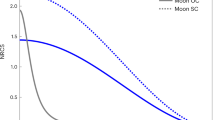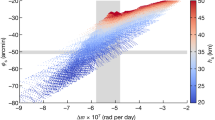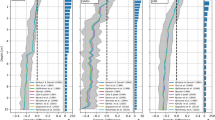Abstract
Photographs from Voyager Missions reveal a great variety of surface features for the icy satellites of Saturn1. Mimas is covered with many old craters. Enceladus has a rather smooth surface with few and rather young craters. Some parts of Dione's surface have an important crater density, whereas other parts are relatively smooth. Thus some of Saturn's icy satellites seem to have undergone important surface modifications during their history while others did not. I suggest here that the irreversible phase transition between amorphous and cubic ice and similar phase transitions may provide a low energy resurfacing mechanism for these icy satellites.
This is a preview of subscription content, access via your institution
Access options
Subscribe to this journal
Receive 51 print issues and online access
$199.00 per year
only $3.90 per issue
Buy this article
- Purchase on SpringerLink
- Instant access to full article PDF
Prices may be subject to local taxes which are calculated during checkout
Similar content being viewed by others
References
Smith, B. A. et al Science 212, 163–190 (1981).
Mitchell Waldrop, M. Science 213, 1236–1240 (1981).
Klinger, J. Science 209, 271–272 (1980).
Peale, S. J., Cassen, P. & Reynolds, R. T. Icarus 43, 65–72 (1980).
Smoluchowski, R. Astrophys. J. Lett. 244, L31–L34 (1981).
Klinger, J. Icarus 47, 320–324 (1981).
Ghormley, J. A. J. chem. Phys. 48, 503–508 (1968).
Yoder, C. F. Nature 279, 767–770 (1979).
Ross, R. G., Anderson, P. & Bäckström, Nature 290, 322–323 (1981).
Gaffney, E. S. & Matson, D. L. Icarus 44, 511–519 (1980).
Author information
Authors and Affiliations
Rights and permissions
About this article
Cite this article
Klinger, J. A possible resurfacing mechanism for icy satellites. Nature 299, 41 (1982). https://doi.org/10.1038/299041a0
Received:
Accepted:
Issue date:
DOI: https://doi.org/10.1038/299041a0



